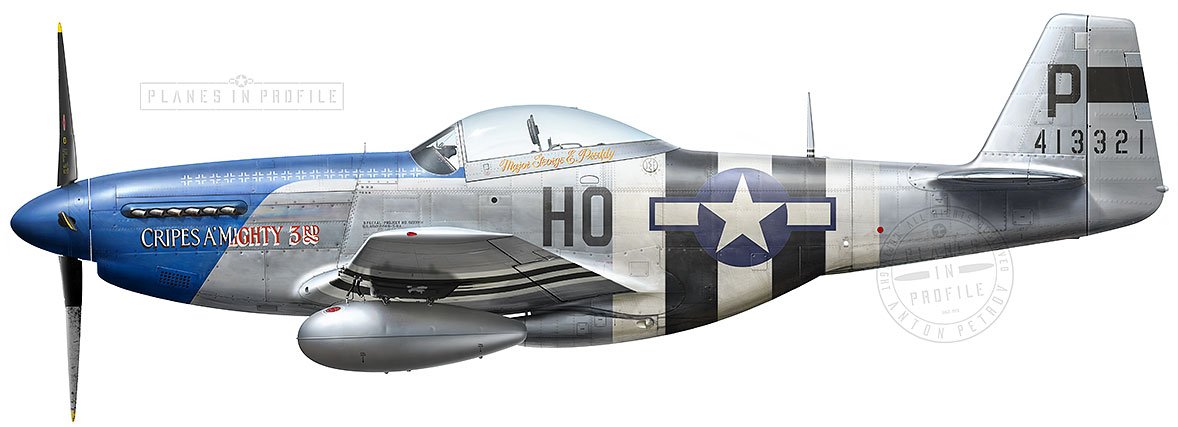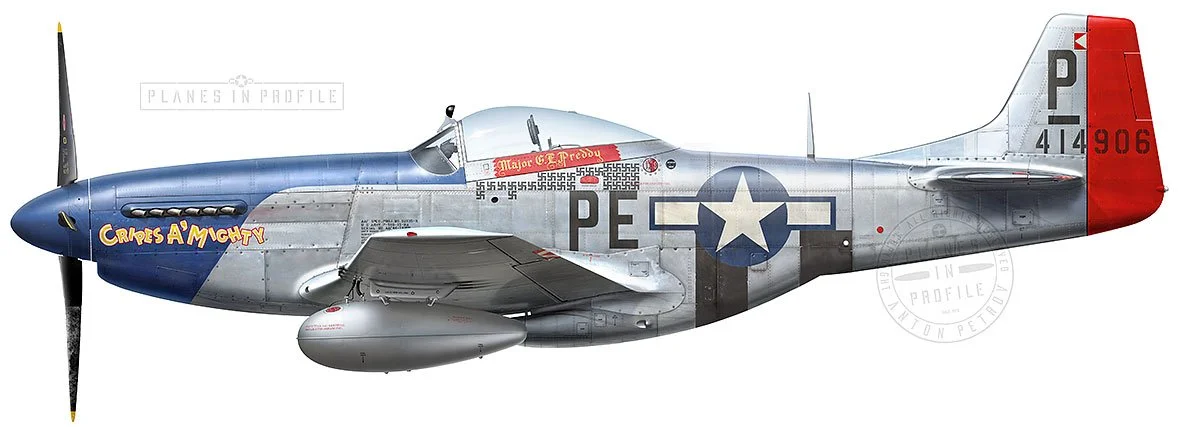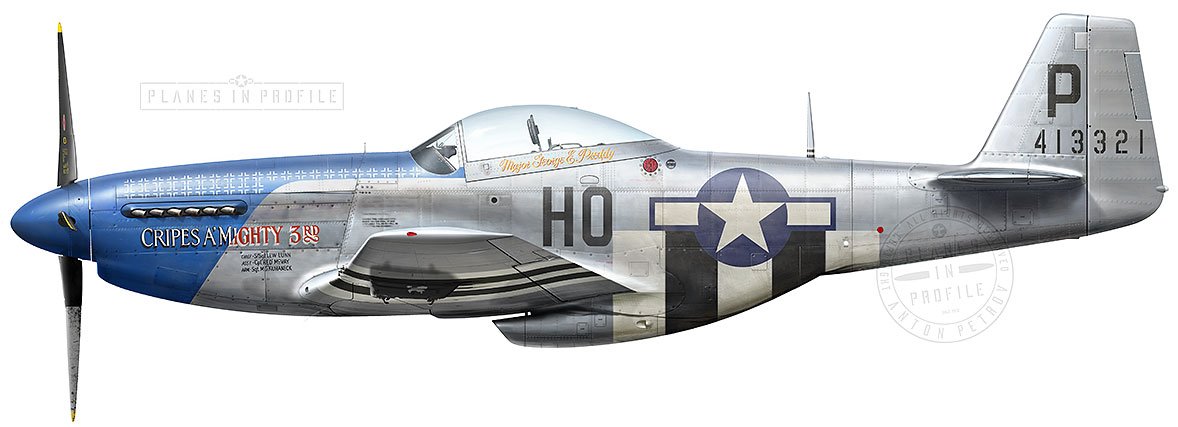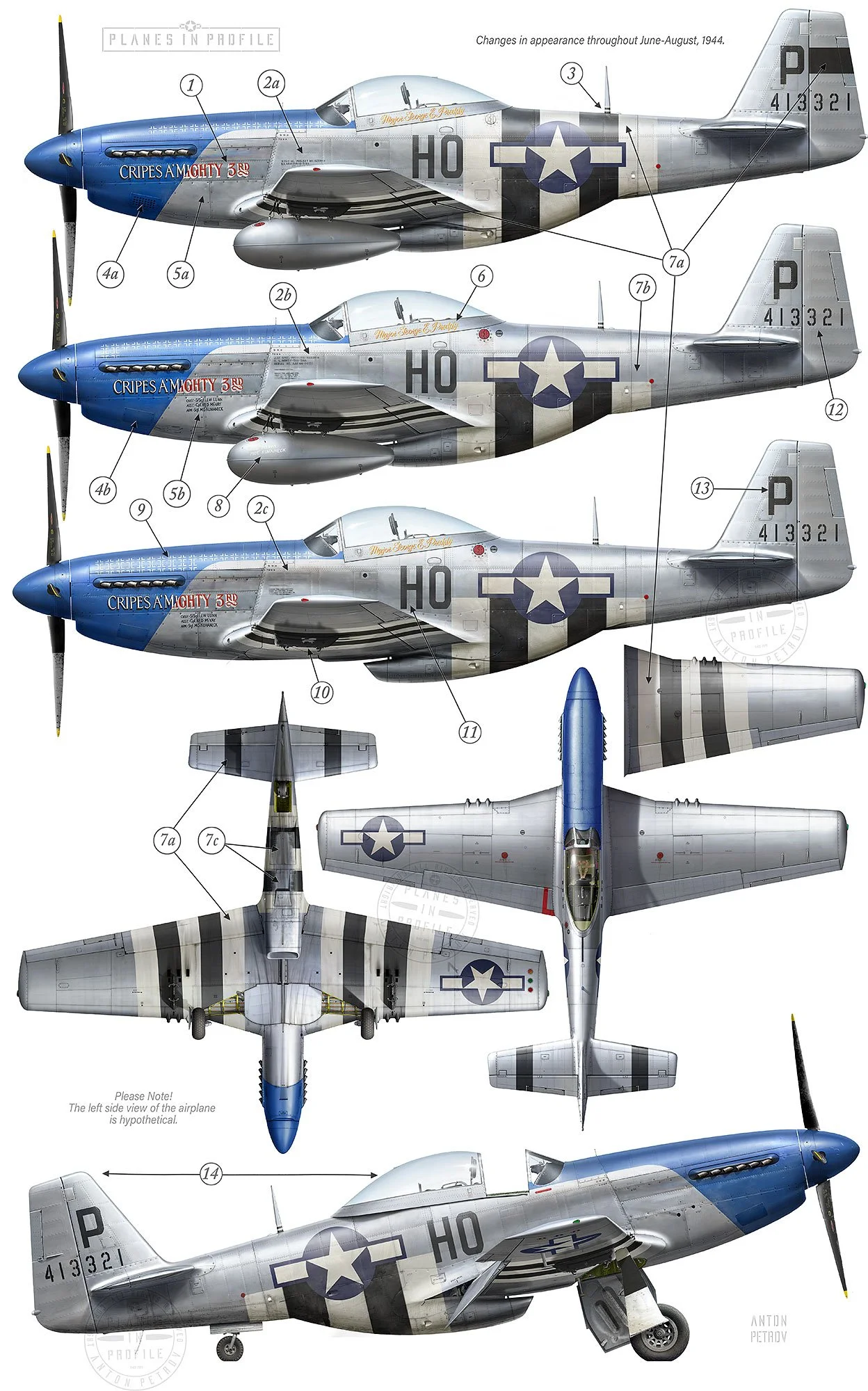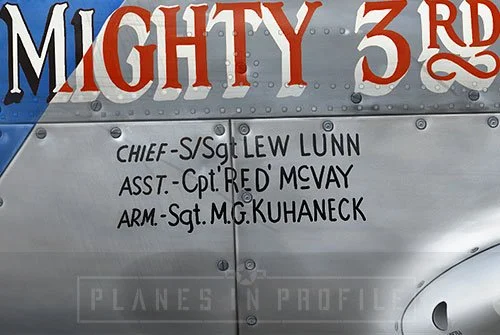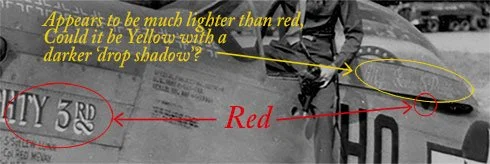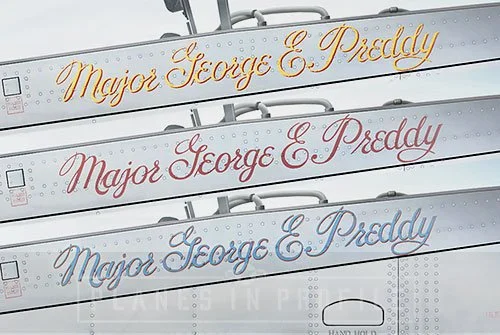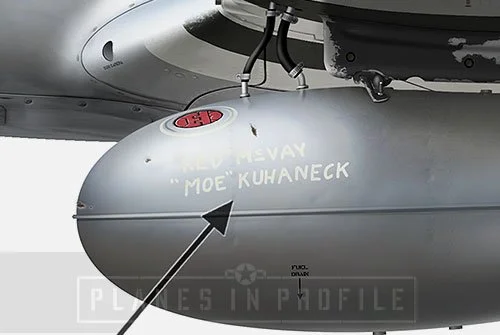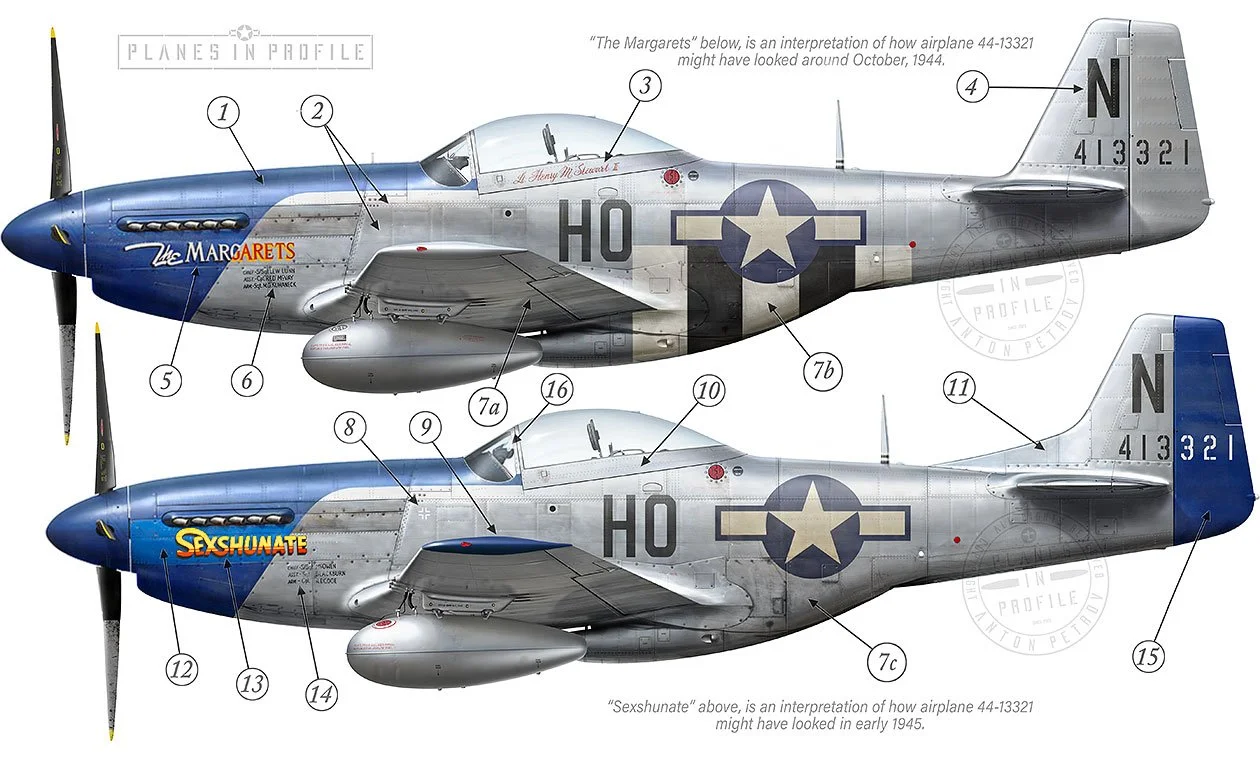Preddy’s “Cripes A’ Mighty 3rd” / Stewart’s “The Margarets”/ Nutter’s “Sexshunate”
North American, P-51D-5NA (Mustang), Serial number 44-13321
While flown by Preddy
487th Fighter Squadron, 352nd Fighter Group, 8th Air Force, Bodney, England, June-August, 1944
Flown by Maj. George Earl Preddy Jr. (Ratsy), (Widely considered to be WW2’s highest-scoring Mustang ace, with 26 aerial victories in WW2, plus 3 probable, plus 4 damaged, plus 5 on the ground)
Cripes A’Mighty 3rd as it looked in June 1944
The Mustang with serial number 44-13321 was one of the first bubble-top P-51Ds received by the 352nd Fighter Group. It was assigned to a fighter ace by the name of George Preddy who called it “Cripes A’ Mighty 3rd” . This machine became one of the most famous, if not THE most famous, Mustangs of WW2 because it was the airplane in which Maj. George Preddy went on to score the majority of his aerial victories, eventually becoming the highest-scoring P-51 ace in the world.
By the time Preddy began flying “Cripes A’ Mighty 3rd”, he already had 8.833 aerial victories plus 1 damaged, plus 4 ground victories, to his name. His first victory in CripesA’Mighty 3rd occurred on the 20th of June 1944 and over the next month and a half, he went on to rack up an impressive 14 aerial kills, plus 2 probable and 2 damaged, as well as one ground victory. These victories were[1]:
9.833,10.33) June 20, 1944, 1 x FW-190, east of Bernburg (Germany)
0.5 x Me-410 east of Bernburg (Germany)
11.333) June 21,1944 1 x Me-109 east of Magdeburg (Germany)
12.333) Jul. 18, 1944 1 x Me-109 north-east of Rostock (Germany)
13.333) 2 x Ju-88 north-east of Rostock (Germany)
1 x Ju-88 (probable) north-east of Rostock (Germany)
2 x Ju-88(damaged) north-east of Rostock (Germany)
14.833) Jul. 21, 1944 0.5 x Me-109 east of Munich (Germany)
15.833) Jul 29, 1944 1 x Me-109 vicinity of Naumburg (Germany)
16.833) Aug 5, 1944. 1 x Me-109 south of Hamburg (Germany)
1 x Me-109(probable) south of Hamburg (Germany)
17.833,18.833,19.833,20.833,21.833) Aug 6, 1944 6 x Me-109 Lüneburg to Havelburg (Germany)
(Please note that Preddy is said to have scored 1 ground victory sometime between July 21and Aug 5[2] )
The 6 last victories which occurred on August 6th were undoubtedly Preddys most impressive daily score up to that point. It is even more impressive knowing that all 6 victories were scored in one aerial battle, and even more impressive knowing that Preddy was severely hung over from the night before when he led his squadron into that air battle! Here is how it happened:
On the evening of August 5th, the pilots of the 486th squadron learned that the mission on the 6th will be postponed due to bad weather, so they went to the Officer’s Club to celebrate the successful air battle from earlier that day. G.Preddy had an especially good time that evening; he won $1200 cash in a game of craps (an equivalent of several months’ pay at that time!) and ended the night being wonderfully drunk. Unfortunately for Preddy, the expected bad weather didn’t arrive the next morning, and after having slept for no longer than 1 hour following the big night, he was awoken by the duty officer informing him that the mission is back on.
Preddy’s drunkenness hadn’t even had time to transition into a hangover yet by the time he appeared at the mission briefing, but he managed to clear his head enough to take notes and to lead his men on a sortie to escort B-17s from Hamburg to Berlin. Once in the air, though, his hangover got the better of him, and the nauseated Preddy vomited in the cockpit of “Cripes A’ Mighty 3rd”. This helped to clear his head somewhat, and 90 minutes later, when the Bluenosers spotted a gaggle of 30-plus Me-109s, Preddy was ready for a fight.
Preddy’s White Flight - consisting of Lt. Heyer, Lt.Doleac, and himself, was flying 1000 feet above and at the back of the lead combat wing of the bombers. From this hight, “Cripes A’ Mighty 3rd” and the other two Bluenosers dove onto the enemy fighters. G.Preddy’s encounter report tells the rest:
‘I opened fire on one near the rear of the formation from 300 yards and got many hits around the canopy. The enemy aircraft went down inverted and in flames. At this time, Lt. Doleac became lost while shooting down an Me-109 that had latched onto Lt. Heyer’s tail. Lt. Heyer and I continued our attack and I drove up behind another enemy aircraft, getting hits around the wing roots and setting him on fire after a short burst. He went spinning down and the pilot bailed out at 20,000 ft. I then saw Lt. Heyer on my right shooting down another aircraft.
‘The enemy formation stayed together taking practically no evasive action, and tried to get back for an attack on the bombers which were off to the right. We continued our attack on the rear end and I fired on another at close range. He went down smoking, and I saw him begin to fall apart below us. At this time four other P-51s came in to help us with the attack. I fired at another ’109, causing him to burn after a short burst. He spiralled down to the right in flames. The formation headed down in a left turn, keeping themselves together in a rather close formation.
‘I got a good burst into another one, causing him to burn and spin down. The enemy aircraft were down to 5000 ft. now, and one pulled off to the left. I was all alone with them now, so I went after this single ’109 before he could get on my tail. I got in an ineffective burst, causing him to smoke a little. I pulled up into a steep climb to the left above him and he climbed after me. I pulled it in as tight as possible and climbed at 150 mph. The Hun opened fire on me but could not get enough deflection to do any damage. With my initial speed, I slightly out-climbed him. He fell off to the left and I dropped astern of him. He jettisoned his canopy as I fired a short burst, getting many hits. As I pulled past, the pilot bailed out at 7000 ft. I had lost contact with friendly and enemy aircraft, so I headed home. I claim SIX (6) Me-109s destroyed.’ [3]
For this achievement, Preddy received a Distinguished Service Cross and was given a well-deserved one month’s leave to visit home in the USA. After Preddy’s leave in September, he was made commander of 352nd's 328th Fighter Squadron and was assigned a different Mustang (serial number 44-14906), which he also called ‘Cripes A’Mighty” .
The illustration above shows P-51D-15NA, serial number 44-14906 which was assigned to George Preddy after “Cripes A’ Mighty 3rd”. Maj. Preddy went on to score 4 more aerial victories, plus 1 probable and 1 damaged in this airplane. George Preddy died tragically when 44-14906 was hit by friendly anti-aircraft fire.
Flown by others
September 1944-April 1945
Bodney in England, Asch (Y-29) and Chiévres (Y-84) in Belgium
During September 1944, while Preddy was on leave, his “Cripes A Mighty 3rd” remained in the 487th squadron and was flown by other pilots. On the 10th of September, for example, it was flown by J.C. Meyer, who scored four ground victories in it.
Cripes A’Mighty as it might have looked in September 1944, when Meyer scored 4 ground victories in it.
In that same month of September, “Cripes A’ Mighty 3rd” was reassigned to Capt. Henry Stewart, who renamed it to “The Margarets”, and the plane’s code was changed to HO-N. Stewart went on to score 4 aerial victories, but none of them while flying this machine [4]. Therefore, most likely, no victory markings appeared on this airplane while flown by Stewart, which was presumably between September and November of 1944, as can be seen in this photo.
Ex. Cripes A’Mighty 3rd, as it might have looked around October, 1944.
In November ,“The Margarets” (44-13321) was swapped for a P-51D-10 serial number 44-14716, which Stewart also called “The Margarets” [5]. In the meantime, airplane number 44-13321 was reassigned to Lt. Marion Nutter, who renamed it “Sexshunate” (pronounced “Section 8”) but retained the HO-N code. Nutter already had one aerial victory by this time, he scored it in May 1944 (It appears to have been painted onto the side of “Sexshunate”). He went on to score three more aerial victories after being assigned plane 44-13321, all three scored in December, 1944. I was unable to confirm if these victories were scored in Sexshunate, but the time during which Nutter flew Sexshunate seems to match the dates of these victories:
Dec 26. 1x Me-109, circa Ollheim (Germany)
Dec 27. 2 x Me-109, near Bonn (Germany)
Ex.The Margarets, as it might have looked in early 1945
”Sexshunate” was also flown by Lt. Ray Little and Lt.Warren Padden, the latter of whom was the last man to fly this warbird.
On 16th of April 1945, less than a month before the end of WW2 in Europe, while piloted by Lt.Warren Padden, this most legendary of P-51 Mustangs was shot down by flack fire. Padden perished with the airplane.
Combining all the victories scored in this warbird by the different pilots who flew it (18.5 enemy aircraft in the air and 9 on the ground?) makes airplane 44-13321 “the highest-scoring Mustang of WW2”, a truly legendary war machine!
Noteworthy Visual Characteristics
While flown by G.Preddy
1) “Cripes A’ Mighty” is a nickname given to Preddy’s airplane. It’s derived from the phrase that Preddy yelled when he released the dice whilst playing craps! He was a keen craps player. Plane 44-13321 was Preddy’s third airplane nicknamed ‘Cripes A’ Mighty’, hence the designation ‘3rd’. His first was a Thunderbolt P-47D, 42-8500, and his second was a P-51B-10 42-106451.
The name was probably painted by Sgt. Sam Perry, who did this for most planes of the 487th squadron.
2) Note the difference between the data stencils on the airplane between June-August 1944. It seems like only the bottom part of the data stencil appeared on the airplane in June, as shown by ‘2a’. Then the whole stencil seems to have been replaced with a new one as marked by ‘2b’. In August the top part of the stencil appears to have been mostly rubbed off (2c) probably due to cleaning/polishing of the airplane.
3) Note the stripes at the bottom of the antenna mast.
4) Note the carburettor air filter intake grill has been replaced with a solid plate in July.
5b) This marking identifies the crew of the airplane. The crew were:
Crew Chief - Senior Sergeant Lew Lunn
Assistant - Captain ‘Red’ McVay
Armourer - Sergeant M.G.Kuhaneck
Note that this info was missing on the airplane initially, as marked by ‘5a’
6) G.Preddy’s name on the canopy rail is usually interpreted as being ‘red’ or sometimes as ‘red with a blue outline’ or vice versa, but based on the photo reference the colour of the name looks undeniably lighter than red or blue, as per the image below.
Knowing that yellow and orange colours have been used to paint various details on the planes of 487th FG, perhaps Preddy’s name was painted in yellow or orange? This is a little controversial but I’ve decided to go with this option anyway, because red or blue name does not agree with what we actually see in the photo reference (One example shown below).
It’s worth noting that the name appears to have a drop shadow, this could have been red or blue.
7a) The D-Day stripes. Note that the stripes on the fuselage and the stripes on the wings initially wrapped all the way around the top and bottom of the fuselage and wings. Although, the stripes might not have covered the bottom of the fuselage entirely, as shown by ‘7c’, because this part of the plane wasn’t always easy to reach for the painters while the tail of the plane was standing on the ground.
Due to a Field Order issued on July 4th, the invasion stripes have been removed from the upper surfaces of the fuselage and wings and then covered only the lower part of the fuselage as shown by ‘7b’ and the lower surfaces of the wings (the upper surfaces of the wings had the stripes removed).
8) Note that an interesting detail appeared on the plane’s drop tank in late July, as can be seen in this photo. It looks like the names ‘Red’ McVay and “Moe” Kuhaneck were written on the port side drop tank, using some very light colour paint, possibly white or yellow. The starboard side drop tank also had something written on it, as can be seen in this photo. It was possibly the same names as on the left side tank.
9) 31 small “Balkenkreuz”s represent G.Predy’s personal victories, presumably at the time he stopped flying this airplane. However, there seems to be a discrepancy between the number of his confirmed victories and what appeared on his machine.
By the time Preddy stopped flying this airplane in August 1944 he had a total of 22.833 aerial victories, plus 2 probably destroyed (in the air), 3 damaged and 5 destroyed on the ground, or a total of 29.833 (which can be rounded off to 30) destroyed (including the 2 probables). But the airplane in the photos shows 31 victory markings instead of 30, which is more destroyed airplanes than has been attributed to Preddy by September 1944.
10) The bomb racks appear to have been painted black, which would make sense since they happened to be positioned in the part of the wing covered by the black D-Day stripe.
11) ‘HO’ was the identification code of the 487th Fighter Squadron.
12) 44-13321 was the serial number of the airplane. These were usually written on the vertical fin/rudder without the first digit, so in this case as 413321.
13) ‘P’ on the tail was the identification code of Preddy’s airplane.
14) Note that the antenna wire seems to be missing, as on many Mustangs of the 352nd FG.
15) The swept-back ‘Blue Nose’ was the identification marking of the 352nd Fighter Group. It made its first appearance on the group’s Mustangs in late April 1944. Because of this marking the unit and its airplanes were often called the ‘Bluenosers’. Sometimes the 352nd Fighter Group is even referred to as the ‘Blue-nosed Bastards of Bodney’. The latter name is based on the rumour that that when the unit’s mustangs with their distinctive blue noses made their first appearance over Germany, the head of the Luftwaffe, Reichsmarschall Hermann Göring, reportedly said: ‘I knew the war was lost when I saw the “Bluenosed Bastards of Bodney” over Berlin’! [7] In reality there is no evidence that Göring actually said this and the name ‘Blue-nosed Bastards of Bodney’ was most likely made up some time after the war.
With all the fame surrounding the ‘Bluenosers’ I had difficulties finding out which shade of blue was used by the unit exactly. Turns out that possibly various shades of blue were used. The very early examples of the blue that was used on the noses of the unit’s airplanes which were painted in Olive Drab was a very light shade of blue. However the colour became darker medium blue once the “aluminium’ coloured Mustangs started to arrive to the unit. The exact paint name of this ‘medium blue’ is unknown as far as I could find in my research. I have also read that later the colour “RAF Deep Sky Blue” was sometimes used for the noses too, which was darker yet again. Bellow are some examples of colour photos of the Bluenosers. Here are some additional links to colour photos of the Bluenosers from WW2:
https://www.americanairmuseum.com/archive/media/media-400726jpg
https://www.americanairmuseum.com/archive/media/media-387702jpg Not that the two Bluenosers in this image have a different shade of blue on the nose.
https://www.americanairmuseum.com/archive/media/media-388403jpg
Because the tone of “‘Petie 3rd”’s nose appears to be slightly lighter than the insignia in the b/w photos, I chose to use a slightly lighter/brighter blue colour in my artwork also.
The photos above are low resolution screen grabs taken from copyright-free images on Wikipedia. To find the original high resolution photos please go to these pages:
https://en.wikipedia.org/wiki/352nd_Fighter_Group
https://en.wikipedia.org/wiki/RAF_Bodney
The Margarets and Sexshunate
1) The nose of the airplane appears to be quite dark in the photo reference. It was probably freshly repainted and possibly with a darker blue.
2) Note that the data stencil is completely gone.
3) The name on the canopy rail was replaced with Lt. Henry M. Stewart II.
4) The airplane’s code was changed to N and remained the same even when the plane was changed to Sexshunate.
5) “The Margarets” was the nickname H.Stewart gave his airplane. At this stage I was unable to find out the story behind the meaning of the nickname.
6) It appears that The Margarets was serviced by the same crew as Cripes A’Mighty 3rd.
7a) The D-day stripes on the bottom of the wings appear to have been erased, but perhaps with some faint traces of the stripes remaining.
7b) We can’t see in the photo reference if the D-day stripes on the fuselage were erased or not. However, they still appeared on an early photo of Sexshunate. So it makes logical sense to presume that they must have still appeared on The Margarets also. It’s worth noting that the two outer white stripes might have been removed first (either on The Margarets or Sexshunate), before the rest of the stripes were completely removed on Sexshunate (7c) as can be seen in this photo showing stripeless Sexshunate in the background.
8) It looks like M.Nutter’s one aerial victory (by the time he started flying this plane he already had one victory) appeared on the airplane. Strangely, it looks very dark in one photo and extremely light, possibly even white, in another (presumably a later photo). I am not sure what might explain this extreme colour difference, other than the presumption that the marking was repainted for spree reason.
9) The tip of the wing (presumably on both wings) was painted with a darker colour, possibly blue, like the rudder
10) Nutter’s name is not visible on the canopy rail in the photo reference. It’s possible that it was painted with a very light colour (yellow?) or perhaps it wasn’t painted on the rail at all. In my artwork I decided to stay true to the reference image and leave the canopy rail looking blank.
11) Note that Sexshunate was retrofitted with a fin fillet.
12) Note that the cowl panels behind the name '“Sexshunate” look lighter than the rest of the cowling. It’s likely that a lighter shade of blue was used to paint over the name “The Margarets” in preparation for painting the name “Sexshunate”.
13) M.Nutter nicknamed the airplane “Sexshunate”, pronounced ‘Section eight’. This was Nutter’s comical twist on Section VIII of the WW2–era United States Army Regulation 615–360, concerning the separation of enlisted men from military service. Section VIII provided for the discharge of men who were deemed mentally unfit for military service.
14) Sexshunate was serviced by a different airplane crew to the one before, the names of the new crew were:
Crew Chief - Senior Sergeant McOwen
Assistant - Sergeant Blackburn
Armourer - Corporal R.Dodge
15) The blue rudder became the identification marking of the airplanes of the 487 squadron from late 1944.
16) Though it’s not clear in the photo reference, it is possible that the gunsight was replaced from the earlier N-9 reflector version (with a ‘ring and bead’ sight - that little antenna-like protrusion on the nose in front of the windscreen) to a more advanced, gyroscopically-stabilised K-14A gunsight.
FOOTNOTES
[1] List of victories is based on ‘Stars & Bars, a tribute to the American fighter ace 1920-1973’, by Frank Olynyk, published by Grub Street in1995, p507-508, ISBN 1-898697-17-5
[2] ‘P-51 Mustang Aces, Combat biographies of fifty-five legendary World War II P-51 fighter aces’ , by William N.Hess and Thomas G. Ivie, published by Motorbooks International in 1992, p.104, ISBN 0-87938-530-8
[3] Based on Preddy’s encounter report as described in the book “352nd Fighter Group”, by Thomas G. Ivie, published by Osprey Publishing in 2002, p.79-80. PDF e-book iSBN: 978 1 84603 755 9
[4] Based on the book “352nd Fighter Group”, by Thomas G. Ivie, published by Osprey Publishing in 2002, p.110. PDF e-book iSBN: 978 1 84603 755 9
[5] The serial number of the second “The Margarets” is based on the information on the littlefriends.co.uk website.
[6] Based on the book “352nd Fighter Group”, by Thomas G. Ivie, published by Osprey Publishing in 2002, p.6. PDF e-book iSBN: 978 1 84603 755 9
[7] Info taken from the book “352nd Fighter Group”, by Thomas G. Ivie, published by Osprey Publishing in 2002, p.6.
SUMMARY OF LINKS TO THE REFERENCE IMAGES
Many photos of CripesA’Mighty 3rd can be found on this awesome webpage about G/Preddy.
https://crazyhorseap.be/mustangs/aces-high/preddy%2C-george-e.html
Photo of The Margarets can be found here:
https://crazyhorseap.be/____impro/1/onewebmedia/Mustangs/Aces/Preddy%20George/44-13321%20as%20flown%20later%20by%20Capt%20Henry%20Stewart.jpg?etag=%2214d049-5ebe6827%22&sourceContentType=image%2Fjpeg&quality=85&ignoreAspectRatio&resize=1500,1102
Photos of Sexshunate can be found here:
http://www.littlefriends.co.uk/wp-content/groupimages/gallery/352g/ho-n.jpg
https://www.shorpy.com/node/4750
In this photo Sexshunate appears in the background
http://www.littlefriends.co.uk/wp-content/groupimages/gallery/352g/ho-w2.jpg
All the work presented on this is page is subject to updates and revisions in the light of new information which might present itself. If you have any new information relevant to this page or disagree with anything that's presented here, then please feel free to contact me through the Planes in Profile Facebook page. Thanks:)

